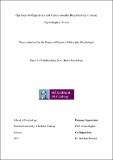Openness to experience and cardiovascular responsivity to acute psychological stress

View/
Date
2017-02-07Author
Ó Súilleabháin, Páraic
Metadata
Show full item recordUsage
This item's downloads: 65 (view details)
Abstract
Introduction. Research has implicated the personality trait of openness to experience - an
individual’s propensity to be open to a variety of experiences, with a need to enlarge and
examine experience - in the context of health outcomes, and in particular cardiovascular
wellbeing. However, potential mechanisms remain unclear. The present research sought to
determine if openness is relevant to consider within the context of cardiovascular responsivity
to acute psychological stress.
Methods. Four empirical studies are reported. In a sample of 77 female college students,
Study 1 examined if openness is associated with cardiovascular responsivity across a protocol
consisting of repeated stress exposures. Utilising the sample from the aforementioned Study
1, Study 2 investigated cardiovascular trajectories through a magnification of the initial stress
exposure. In a sample of 91 college students (84 females and 7 males), Study 3 examined
whether openness was associated with cardiovascular response trajectories across a protocol
consisting of differing stressors. Addressing a potential threat to validity within Study 3,
Study 4 (comprising of 98 female college students) investigated if openness is associated
with differing cardiovascular responses to stress incorporating social evaluation.
Results. Study 1 indicated that openness was associated with cardiovascular response
trajectories across a protocol consisting of repeated stress exposures. Persons in the highest
and middle tertiles of openness exhibited similar systolic and diastolic blood pressure.
Conversely, those lowest in openness displayed low blood pressure responsivity. Persons
highest in openness also displayed lower cardiac output throughout the protocol. Study 2
found that openness was associated with cardiovascular responsivity within the stress exposure. Specifically, those highest in openness were found to display an elevation of
systolic blood pressure and heart rate responses during the exposure. Additionally, persons
highest in openness exhibited a distinctly adaptive myocardial hemodynamic profile
throughout the stress exposure. Study 3 found that openness was associated with responsivity
across a protocol consisting of differing stressors. More specifically, openness was associated
with systolic blood pressure, diastolic blood pressure, and heart rate responsivity. When
examining patterns of adaptation, persons in the lowest and middle tertiles exhibited stable
patterns of responsivity from one task to the next. Those highest in openness exhibited
patterns of habituation to the second differing stressor. Study 4 did not uncover evidence that
openness is associated with differing cardiovascular responsivity to stress incorporating
social evaluation.
Conclusions. The findings provide evidence for cardiovascular stress responsivity as being a
potential mechanism in reported openness-health associations. Persons highest in openness
were found to display healthful cardiovascular response trajectories, displaying patterns of
habituation of cardiovascular responses to different stressors, and exhibiting an adaptive
hemodynamic response profile. Individuals lowest in openness were found to be
characterised by patterns of cardiovascular functioning which are consistent with the notion
of blunted responsivity, which may indicate disease risk. The present thesis provides
evidence the higher-order trait of openness is of importance within the context of
cardiovascular stress responsivity, thus providing a potential mechanism in reported health
associations.

